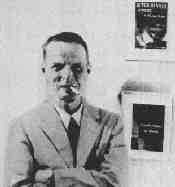Mystery Books
Mystery Movies
Mystery Authors
Cornell Woolrich biography
Cornell Woolrich was born in 1903. He began writing fiction at Columbia University in the late 1920's. His early works are not yet noir (the genre had not yet really emerged) but rather were in the F. Scott Fitzgerald / Romantic Egoist tradition. When the Depression caused him to lose his markets, he turned to the pulp magazines to survive, changing his style to one of dark, brooding suspense. During the 1930's and 40's Woolrich was, along with Raymond Chandler, James M. Cain and Dashiell Hammett, one of the creators of the roman noir genre. Sadly, Woolrich died an alcoholic recluse in 1969.
Woolrich's work was adapted into numerous motion pictures, the best being Robert Siodmak's Phantom Lady (1944) and Alfred Hitchcock's Rear Window (1954).
Woolrich's writing is wonderfully descriptive. His stories are suspenseful and surprising. I Married a Dead Man (written under the name "William Irish" and recently re-released as part of Penguin's Crime Fiction series) is a great place to start reading Woolrich. Here's an excerpt from the beginning:
A surprising number of Cornell Woolrich's stories deal with impossible crimes. Many of his tales of Vanishing Women (which as Anthony Boucher pointed out, was a Woolrich staple) are in fact impossible crimes. How could a woman disappear so completely, that everyone around her would deny her existence? On the surface this seems impossible, yet... These tales include Phantom Lady (1942), and "I Won't Take a Minute" (1940). There are also impossible crimes in "Screen Test" (1934), which is one of Woolrich's earliest mysteries, "Murder at the Automat" (1937), "The Room With Something Wrong" (1938), "Nightmare" (1941), "That New York Woman" (1942) and "Money Talks" (1961). The Night Has A Thousand Eyes (1945), which I have not yet read, also seems to fall into this category. One suspects that there are others scattered through Woolrich's voluminous, still often unreprinted work.
Information source: wikipedia